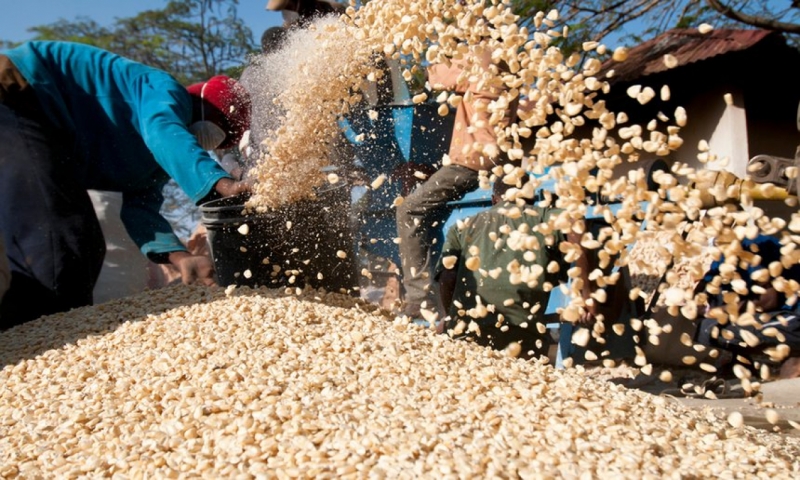




As agricultural production across the world is increasingly threatened by climate change and overpopulation, some farmers are exploring radical alternatives like agroecology – which might just be the answer to global hunger
You wouldn’t necessarily know it, but right now Africa is facing a food crisis. With Brexit, global terror attacks, the war in Syria and the seemingly endless string of sporting fixtures vying for our collective attention in 2016 so far, the fact that up to 50 million people across east and Southern Africa are at risk of hunger seems to have largely escaped mention.
The continent has been wracked by drought following one of the strongest ever El Niños. And while a natural phenomenon is the immediate cause, however, Africa’s food security has been undermined over recent decades by the rise of monocropping – the planting of single-crop tracts across vast swathes of scarce arable land.
Starting in the 1960s, the “green revolution” saw industrial farming practices transplanted to poorer nations. In the second half of the 20th century, its success seemed unassailable: the global harvest of maize, wheat and rice trebled from 640 million tonnes in 1961 to almost 1.8 billion tonnes by 2000.
Africa, in particular, embraced new maize varieties with alacrity. Corn now covers up to 70% of some African nations’ farmland and accounts for about 50% of calories consumed by humans.
But the enormous cost to the land and people is now becoming clear. A recent report by the UN’s Food and Agriculture Organisation (FAO) summed up the problem bluntly, stating: “Past agricultural performance is not indicative of future returns”.
The meticulously-researched document concludes that the green revolution’s “quantum leap” in cereal production has come at the price of soil degradation, salinisation of irrigated areas, over-extraction of groundwater and the build-up of pest resistance. Add climate change into the mix and you have a recipe for disaster. While Africa’s population is set to double to 2.4 billion by 2050, the FAO warns that maize yields could fall by nearly 20% over that period.
The problem is affecting not just quantity, but quality. Lack of rotation and over-use of phosphates and nitrates has degraded the nutrient content of the soil, leaving 2 billion people globally suffering micronutrient malnutrition, many in sub-Saharan Africa.
In fact, soil degradation in Kenya, which I’ve been visiting regularly for more than 35 years, is so severe it’s estimated that the productivity of cropland in the country declined by 40% between 1981 and 2003 as the population doubled.
Productive agriculture isn’t just a nice thing to have. For economies such as Kenya’s, it’s the essential foundation for everything else, generating 30% of GDP and employing more than 60% of the workforce.
Kenya is determined to move its economy away from over-reliance on agriculture by transforming itself into a regional hi-tech hub (dubbed, somewhat inevitably, “Silicon Savannah”) with billion-dollar projects coming down the line. But the context is a country in which up to 4 million people still receive food aid annually.
But there is an alternative that more and more farmers are exploring. Agroecology – an approach which takes into account natural ecosystems and uses local knowledge to plant a diversity of crops that boost the sustainability of the farming system as a whole – is establishing itself in small pockets across Africa.
In east Africa, more than 96,000 farmers have adopted a “push-pull” system for dealing with problematic stemborer pests and striga weed. The system plants maize alongside fodders and wild grasses that “push” pests away, or “pull” them towards decoy plants. Their maize yields have increased from an average of 1 to 3.5 tonnes per hectare without the use of chemical insecticides and with minimal external inputs, according to an evaluation by the Oakland Institute.
Meanwhile, Kenyan farmers are showing how adaptation to climate change can benefit them and the wider economy. Numerous initiatives are encouraging a switch from single-crop maize to drought-resistant and nutritious sorghum and millet, intercropped with legumes. One such scheme in Wote, run by the Kenyan government and crop research body ICRISAT, has seen nearly 400 farmers switch, boosting yields and fetching a better price for their crops.
Agroecology isn’t confined to Africa. In fact, there are examples from across the global south of farmers embracing new thinking to improve their yields and the sustainability of their communities. To cite just one example from Brazil, thousands of hill farmers using mulch to cover crops made up of legumes and grasses saw their maize yields jump from 3 to 5 tonnes per hectare without using chemical fertiliser.
The big question often asked is: can agroecological farming really feed the world, with the global population hurtling towards 9.6 billion by 2050? It’s clear that there’s increasing evidence it could.
A landmark 2001 study by Jules Pretty and Rachel Hine examined 208 projects from 52 countries and found yield increases of 50-100% for rain-fed crops like maize. The cases studied involved 9 million farmers on around 3% of all of the farmed land in Asia, Africa and Latin America and the increases were typically bigger at lower yields, indicating greater benefits for the poorest farmers.
To scale these advances even further, however, we need to radically rethink the economic and social mechanisms that keep farmers trapped on the treadmill of producing for international markets at the expense of themselves and their families. Junking the dogma of monocropping is a crucial part of this process.